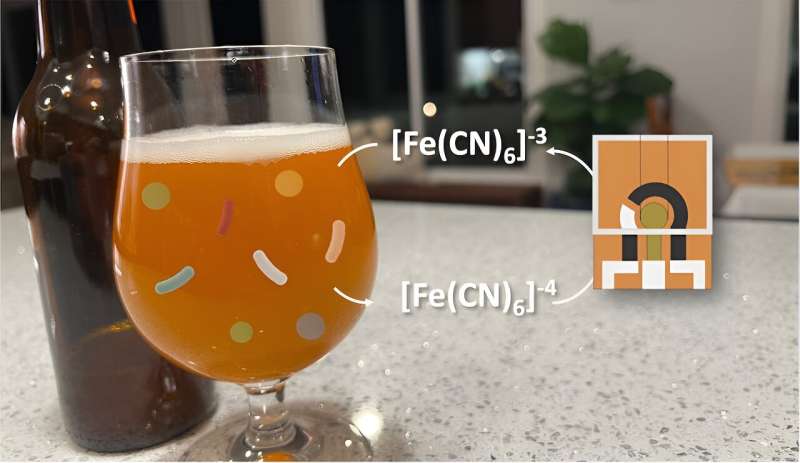This article has been reviewed according to Science X's editorial process and policies. Editors have highlighted the following attributes while ensuring the content's credibility:
fact-checked
trusted source
written by researcher(s)
proofread
How active are the microorganisms in your yogurt? Chemists create a new tool to study probiotic activity

Humans have been fermenting food and drinks—everything from kimchi and yogurt to beer and kombucha—for more than 13,000 years.
Fermentation—a natural process that uses microorganisms to create alcohols and acids from carbohydrates—can preserve food so it lasts longer, and it can enhance the quality of food by turning some components into more easily digestible forms.
Some fermented foods that contain live microorganisms are called probiotics, which can increase the shelf life of food and provide a range of additional benefits, like promoting a healthy gut microbiome and lowering cholesterol levels.
We are chemists, and our team wanted to figure out a way to understand which probiotics are the most active in the body. So, we developed a cardboard sensor that could monitor the metabolic activity of probiotics.
Probiotic health benefits
As they are generally considered safe, probiotics are also one of the most popular dietary supplements in today's market, accounting for more than US$50 billion per year.
Lactobacillus, Bifidobacterium, and Saccharomyces are the most common probiotics. For example, food manufacturers use starter cultures of Lactobacillus bulgaricus and Streptococcus thermophilus to clot milk and make yogurt.
Recent studies have also found that probiotics may prevent the development of harmful bacteria in the body, lower cholesterol levels, reduce constipation, control blood pressure, enhance the production of vitamins, improve calcium absorption and boost the immune system.
However, probiotics can only provide health effects when the microorganisms are alive, meaning they're metabolically active and interacting with the host's body. So, the type of probiotic, its formulation, and how it's processed become critically important.
Analyzing probiotics
Probiotics grow from individual cells into colonies. Food scientists can study probiotics by counting the number of viable cells—also called colony-forming units—in the food to figure out how much they might grow and how active they'll be. They can also study how probiotics respond to a gastric juice made in the lab to simulate how probiotics act in your gut. Gastric juice is the fluid secreted in your stomach during digestion.
However, most of these tests are slow and involve expensive instruments and skilled personnel. That's where our cardboard sensors come in.
Our research team has collaborated with research team from Brazil to develop a simple sensor that can measure the metabolic activity of probiotic foods.
We built the sensors using standard cardboard and a process called laser scribing. We use a laser to convert a small amount of the cardboard into carbon, making it electrically conductive. We also used gold nanoparticles, which further improve the sensor's response by decreasing the material's resistivity.
Lowering the resistivity of the material is important because the sensor detects the metabolic activity of bacteria via a type of chemical reaction called a redox reaction. It can detect the oxidation of a molecule that is produced by one of the probiotics.
Sensor findings
Before testing, the team first calibrated the sensor using a popular probiotic yogurt widely available in U.S. stores as a model. For each test, we only needed to incubate 100 microliters of sample—about 1/50th of a teaspoon—for 10 minutes at room temperature.
Once we calibrated the sensors, we tested how metabolically active the microorganisms present in the sample were. We tested both beer and yogurt and found that the sensors could determine the metabolic activity more accurately than other tests that scientists usually use.
We also found that the bacteria in the beer we tested, an unfiltered IPA, had more metabolic activity than the yogurts, which were popular brands Siggi's, Yakult and Activia.
But, before you run to your local brewery, it's important to note that the sensor only measures the total metabolic activity of the microorganisms present in the sample. It doesn't detect anything about the type of activity or potential health effects.
While several groups have reported on the potential health benefits of beer, not all beers will provide these benefits. And keep in mind that a pint of an IPA carries beneficial bacteria but also a typical alcohol content of between 6% and 8% and 180-200 calories.
Many researchers have performed studies in this field using more traditional probiotic foods that contain many of the microorganisms in your gut. Even in these cases, they've found that probiotics' ability to correct specific health issues is probably limited.
Also, considering the way supplements containing probiotics are regulated, it's hard to say whether the products actually contain the type and amount of viable bacteria advertised on the label.
All things considered, the proposed sensor aims to provide a simple, portable, and low-cost way to detect the activity of live bacteria. These sensors could one day help out in fields like health care.
Provided by The Conversation
This article is republished from The Conversation under a Creative Commons license. Read the original article.![]()





















